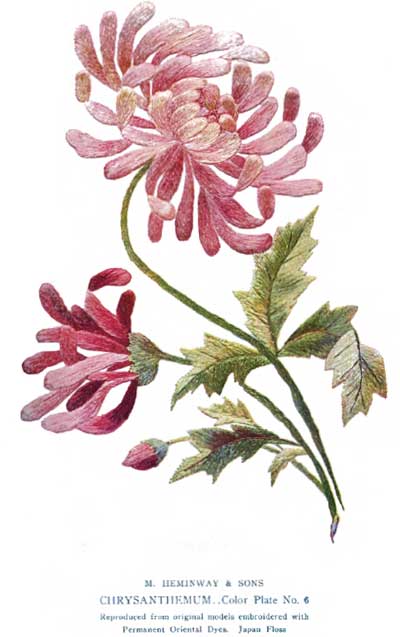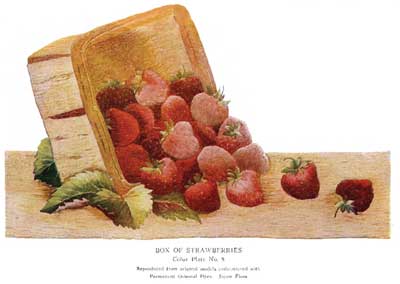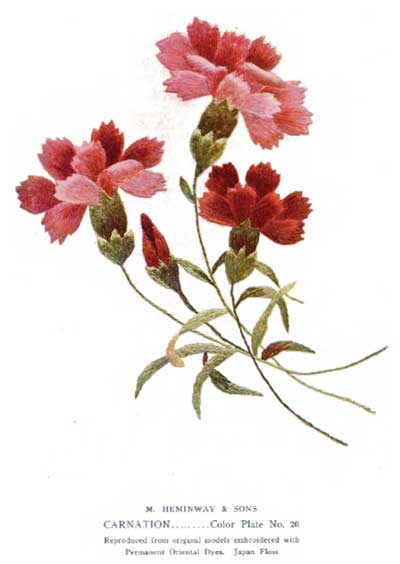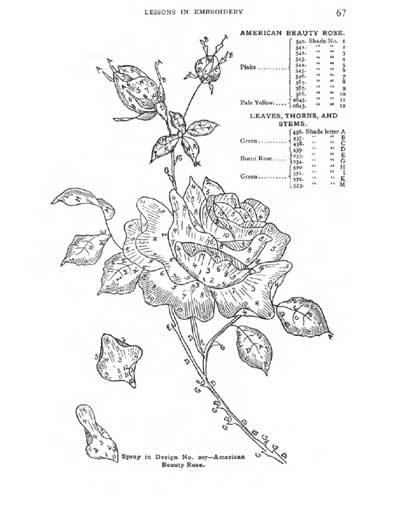The Antique Pattern Library is a real gem of a site when it comes to free online needlework books – it’s an on-going effort of many to preserve old needlework books that are in the public domain. If you haven’t visited the Antique Pattern Library lately, you might want to take a look at some of their new offerings, some of which I wanted to highlight here.
The books I’m looking at today are compiled by M. Heminway & Sons Silk Company. They’re collections of needlework patterns and color plates. In the first book, A Treatise on Embroidery with Twenty Color Illustrations from Original Models. Art Needlework Series No. 8., published in 1910, you’ll find in the first PDF a run-down on embroidery in general, with stitch instructions and so forth.

As you move through the four PDF files that make up the whole book, you’ll come across patterns for a variety of heirloom-type embroidery projects, as well as some gorgeous color plates of exquisite embroidery.

I love, for example, this box of strawberries! Wow. You’ll find instruction on working these projects, too, though the color instructions are directed towards Heminway silks, which can’t be had today.

As you continue to browse through this book in the different PDFs, you’ll come across one beautiful piece of embroidery after another.
In the other book, Treatise on Embroidery, Knitting and Modern Lace Work, with color illustrations from original models. Art Needlework Series Number 6., you’ll not only find some beautiful color plates, but you’ll also find the patterns and color / stitch keys for the different pieces of embroidery featured in the book.

So if you’ve got the time, check out these PDFs. You can find them on the Catalog Listing on Antique Pattern Library. While you’re there, take time to browse all the other offerings – or at least bookmark the page so you can visit it frequently when you’re in the mood for inspiration!
Thanks, Margaret, for the heads-up on these discoveries!







Thanks for the link! There is also a craft Bookshelf at Project Gutenberg which includes the needle arts.
And Google Books has a staggering 2,840 needlework books available for full view & download, not to mention all the others available to preview! Love your site. 🙂 Laura
Oh, I do love the colour plates.
I just received an order of Eterna silk (Thread Express sells colour stash packs of the stranded floss, i.e., flat). I think I may have just the right colours for the carnations….. 🙂
I wonder what kind of silk Heminway sold. Was it flat, twisted, ????
Thanks for the links, Laura!
Margaret, I don’t really know, but here’s a picture of a box of their embroidery silks:
Heminway Silks
I think Eterna would work well for these, but I tend to prefer long and short stitch worked with stranded (spun) silk, like soie d’alger, for some reason – I guess because it isn’t quite as shiny but still has a beautiful sheen. It’s a different kind of sheen, if you know what I mean. But that’s just me, and I think it would be fun to play with it to see how it would turn out!
i just read your email on the free give away.i am new to embroidery. i am a quilter who deceided to do a crazy quilt,so i ordered a few books on embroidery stitches. so i am teaching my self by reading them and your emails.wish me luck.
I am currently doing cross stitch and some very basic needlepoint. I am trying to remember how to needlepoint. I used to do these things and finally have time to do them again. I am very interested in learning to “master” embroidery. Joan
Hello Mary,
I always have problem with the stitch what we call it as honeycomb stitch like in the 5th picture of the following link..
I get the stitch perfect but once the hoop is removed after stitching the threads will become loose and it looks distorted..dont know where exactly I am going wrong..should I make some taka here and there on the laid stitch? Please will you share some tricks as how to do this stitch..
Love n Regards
Lakshmi Sadala
Hi, Lakshmi – My recommendation is that this type of filling is used only in small spaces, and that the vertical and horizontal rows are worked relatively close together, so that the whole area is very “tight” – I would say you’re looking at a space between your horizontal rows and your vertical rows that is around an 1/8″ – unless you’re using a very heavy thread. But for a regular weight thread (say, 2 strands of cotton floss), I’d shoot for about 1/8″ square from your verticals and horizontals, before working the diagonal in. Then the diagonal rows need to be very carefully done, making sure that the over-under sequence is not broken.
Hope that helps!
MC
Thank you very much Mary…will follow your guidelines and revert back to you..
Love n Regards
Lakshmi Sadala
Thank you very much Mary…will follow your guidelines and try once agin and revert back to you ..
Love n Regards
Lakshmi Sadala
Bonjour.pouvez vous me dire ou je peux commander ses livres???merci pour vos réponses
cordialement